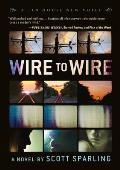
With my previous four posts, I hope I've cemented your impression of me as a serious literary heavyweight. If so, please hold tight to that image. Because now it is time to speak of Seger. And yes, I mean Bob.
Those of you with quick Google reflexes already know that in addition to writing Wire to Wire, I also write The Seger File — the web's largest, oldest, and most complete Bob Seger site.
That explains why Kirkus reviews calls Wire to Wire "a worthy combination of Bob Seger nostalgia and dope-fueled noir," although that's a bit of an overstatement — there are some Seger references in the book, true, but the characters also listen to Iggy, Alice Cooper, and the MC5. It's set in Michigan, after all.
Indeed, I listened to all those bands in the early '70s when I lived in Ann Arbor. In those days, Seger frequently played the bars and clubs down the street, and whenever we had the $3 cover, my roommates and I would go hear him. One night, I stood in a place called the Primo Showbar with about a hundred other fans, certain that the whole world would someday know Seger's voice. I fell under his spell during those shows, and there I remain.
At one show, I took a lucky shot of Seger at the keyboard with my old Nikon. When he did a gig a few weeks later, I stopped him between sets and gave him the photo. A few months later, it appeared on the back of his album, Seven. My brain still hasn't fully recovered from that.

Hitting a high note in 1973: My Seger photo ended up on an album.
By 1997, I was tangled up in Wire to Wire and needed a break. The Internet was something new, so I decided to launch a site on Seger. I'd go to the library, look him up on microfiche, make a copy of what I found, retype the article, and add it to my site. That's how the information superhighway worked back then. We're talking pre-Google, pre-MySpace and Facebook, pre-Wikipedia.
I know there are people who don't get Seger, who know him only from his radio hits. (Which, to my mind, is a little like knowing Louis Armstrong only for "What a Wonderful World." C'mon — the man invented jazz.) If "Old Time Rock & Roll" is the first or only thing that comes to mind when you hear Seger's name, dig deeper.
 You might be surprised to learn, for example, that Seger wrote the first anti-war rock song of the Vietnam era, a defiant rocker called "2 + 2 = ?" And he toured relentlessly, surviving seven years without a hit on the strength of his live show and his work ethic. In print, the best guide to his career is Travelin Man: On the Road and behind the Scenes with Bob Seger by Tom Weschler and Gary Graff.
You might be surprised to learn, for example, that Seger wrote the first anti-war rock song of the Vietnam era, a defiant rocker called "2 + 2 = ?" And he toured relentlessly, surviving seven years without a hit on the strength of his live show and his work ethic. In print, the best guide to his career is Travelin Man: On the Road and behind the Scenes with Bob Seger by Tom Weschler and Gary Graff.
Last month, in the Palace of Auburn Hills outside Detroit, I heard Seger play for more than two hours, as a hometown crowd of 20,000 sang along. In the moments when I had time to think, I asked myself what it is that's kept me captivated for so long.
The answer came in a song he didn't play that night: "Like a Rock." If that's a truck commercial to you, step away from your TV and spend more time with your speakers (or your earbuds). "Like a Rock" is six minutes of testimony to the power of dreams and commitment.
Near the end, a line more spoken than sung asks, "Twenty years, now — where'd they go?" As someone who's spent that amount of time writing a novel, I find the mix of sadness and wonder in the question irresistible. But my connection to Seger is captured most in the last four words of the final verse: "I see myself again."
Maybe because I grew up with Seger's music, maybe because it's so honest, or maybe because of magical reasons that can never be explained, his music has the power to show me things about myself, like good writing sometimes can. I listen to his songs and I see myself again.
That's it for my week of guest-blogging. Thanks, Powell's, for the forum. And thanks to all the friends and readers who have stopped by. I hope you've enjoyed it as much as I have.